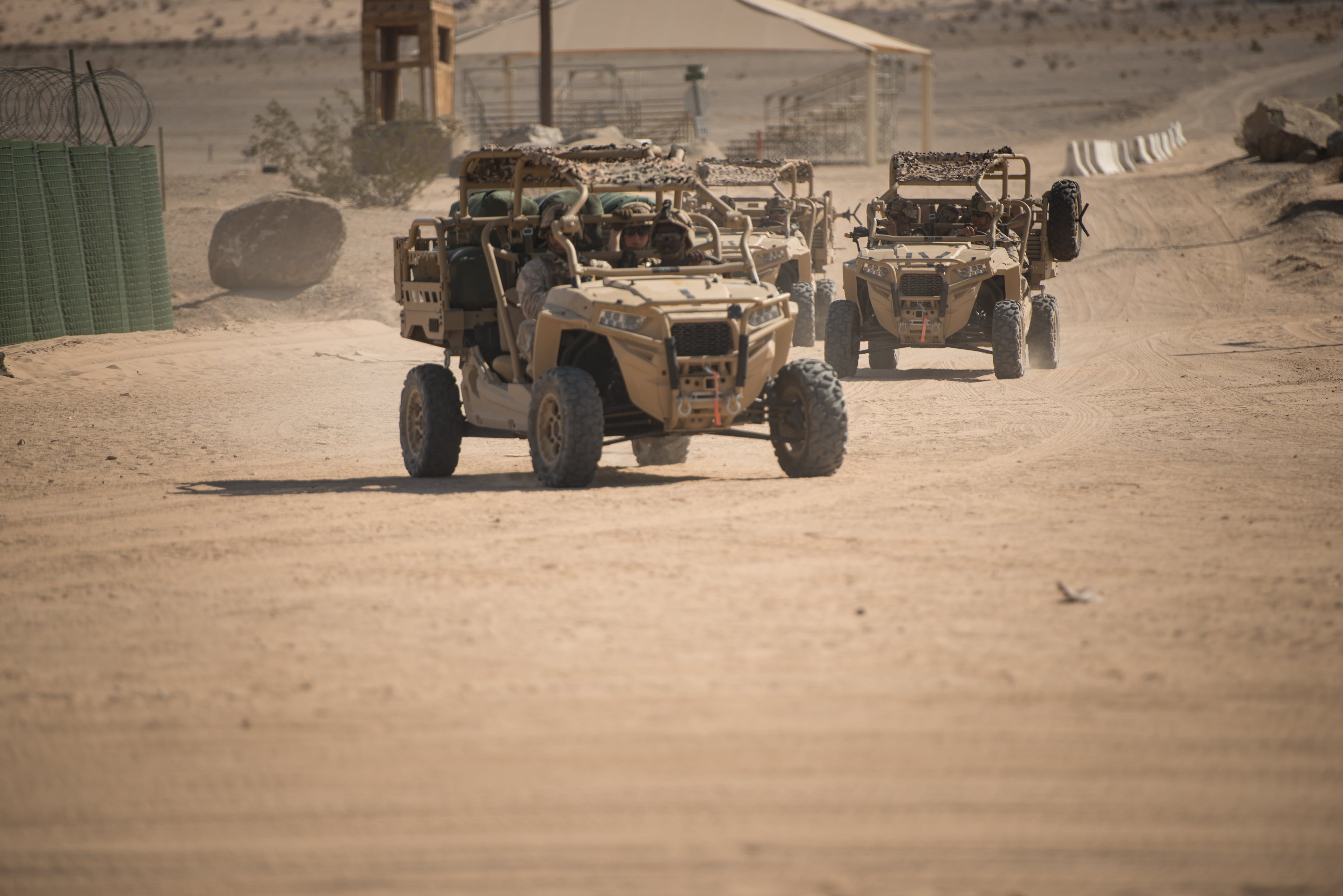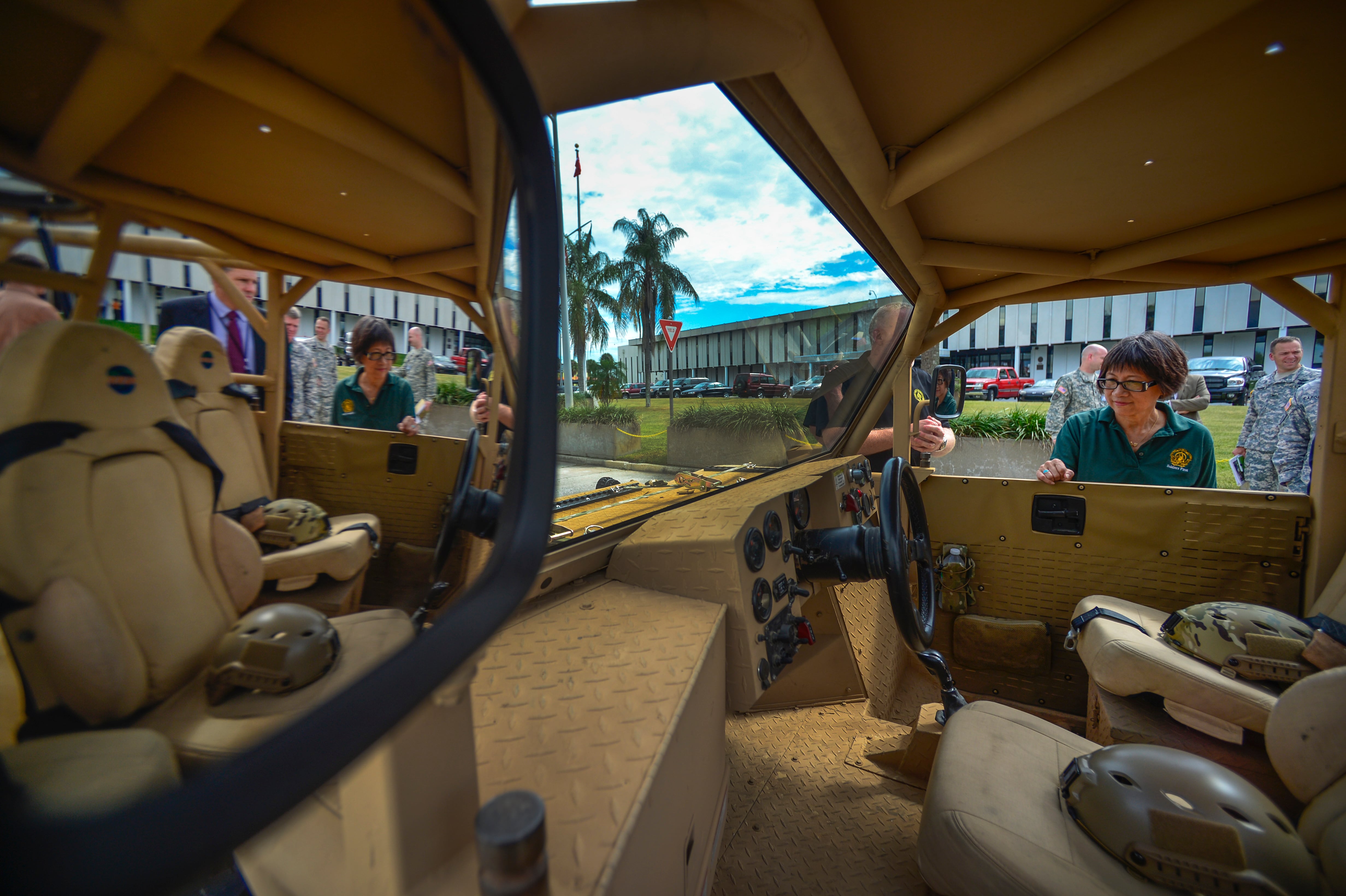Marine Raiders have a surprisingly large fleet of “tactical golf carts.”
As the Marine Corps has sought to get back to its expeditionary roots in recent years, the Corps has invested in a fleet of lightweight vehicles capable of rapid deployment, which includes the Internally Transportable Vehicle — also known as the ITV or “Growler” — along with the MRZR, and, most recently, the new Ground Mobility Vehicle 1.1.
But those soft-skinned trucks have limited armor protections against improvised explosive devices, which continue to be a primary threat in many of the battlefields where the elite Marines operate.
“I’m sure they use it a lot in noncombat advisory roles in Africa,” one Marine told Marine Corps Times on condition of anonymity, referring to the MRZR fielded by the Raiders.
But, the Marine said, “getting a foot outside the wire in Iraq took an act of God, so tactical golf carts wouldn’t cut it.”

Instead, Raiders facing IED threats rely heavily on the Oshkosh M-ATV, a smaller and more agile version of the Mine Resistant Ambush Protected, or MRAP vehicles.
The lightweight ATVs could serve to add maneuverability, scouting and rapid deployment in places like Africa where the improvised explosive device threat is lower.
But that is increasingly unlikely after the recent Oct. 4 attack in Niger that left four U.S. troops dead after their joint patrol with Nigerien forces was ambushed. The attack fueled concerns about the use of unarmored trucks in high-threat areas.
Many of the Raiders’ light tactical vehicles see minimal use except as a daily utility driver on larger overseas outposts or for training and testing.
Nevertheless, military bureaucracy may force the Marine Raiders to replace the Growler, even though the vehicle has seen limited action with elite Marine Corps forces.
The Growler was originally procured by the Marine Corps for the broader infantry force, but the light strike vehicle found its way into the inventories of Marine reconnaissance units and Marine Special Operations Command.
Since MARSOC follows Marine Corps procurement, the Raiders’ Growler may end getting a new fleet of Growlers as part of the Corps-wide replacements, according to Maj. Nick Mannweiler, a spokesman for Marine Special Operations Command.
Yet the vehicle is considered almost useless to the forward-deployed Marines who might use it.
The vehicle has been deployed downrange to places like Afghanistan, where Raiders used it for transportation to and from ranges, or as a daily driver on larger installations like Camp Leatherneck in Helmand province, Afghanistan. It also has served as light security.
Another Marine who spoke to Marine Corps Times on condition of anonymity described the ITV as “horrible,” and said that it was never used.
Insertion Capabilities
The lightweight trucks were designed to support the Marines’ expeditionary and insertion capabilities.
The Growler can be transported inside the Corps’ CH-53 helicopters, the MV-22 Ospreys and its Air Force special operations counterpart tiltrotor, the CV-22. It was initially designed to provide speed, swiftness and light strike capabilities.
But the vehicle has little to no armor. Moreover, MARSOC operators already have another vehicle that they consider their variant of the ITV — called the MRZR — also capable of deployment on the MV-22 and CV-22.
But the MRZR, made by Polaris, is nothing more than a souped-up all-terrain vehicle capable of carrying several Marines and combat equipment.
The MRZR has been deployed overseas, but has not seen any actual combat operations, according to Mannweiler. It’s not really a suitable vehicle for those kinds of operations, he told Marine Corps Times.
Conventional Marine forces have also been experimenting with potential concept of operations with the MRZR. Back in July of 2016, Kilo Company, 3rd Battalion, 5th Marine Regiment tested the MRZR at the Marine Corps Air Ground Combat Center Twentynine Palms, California, as part of an experiment to test whether the vehicle could aid in maneuverability for Marine forces.

But there’s little evidence that Marine Raiders are using those vehicles for operations, because of their limited protection.
“They aren’t being used really … no one will approve any real operation with MRZR,” a Marine told Marine Corps Times. “They are utility carts for running errands. We’ve used them for recon in training but not in real life.”
Still, in the event of a large-scale conflict and an urgent need to deploy Marines rapidly, the vehicle serves as an added capability, should the Corps need to employ the vehicle on the battlefield.
No deployments for GMV 1.1
The most recent addition to the MARSOC fleet is the Ground Mobility Vehicle 1.1, first delivered to the Raiders in August 2016. It’s a highly mobile vehicle designed for combat and rapid deployment. The vehicle is similar in size to the Humvee, but offers modular configurations that allow operators to prep their vehicles for specific mission sets.
But its future usage is still up in the air. The vehicle is not capable of fitting into an MV-22 Osprey, but it can be carried by the CH-47 Chinook and the special operations variant, MH-47.
Marines have told Marine Corps Times that it is unlikely the GMV 1.1 will ever see use in combat because of its limited armor and protection.
So far, the vehicle has not deployed overseas and there are no plans in the immediate future to deploy the tactical vehicle, according Mannweiler.
“If and when that day comes, operational employment restrictions or limitations are determined by relevant combatant command authorities within their respective areas of operation and not by MARSOC,” he said.
The Raiders only have 21 GMV 1.1 vehicles spread across three battalions, and the current inventory of GMV 1.1s are only initial batch deliveries, meaning the Corps is still in the process of testing and evaluating the truck for future procurement.
“Raiders have and will continue to incorporate the vehicles into unit training program events in order to evaluate potential employment options and best practices for the GMV 1.1,” Mannweiler said.
For now, the Marine Raiders will continue to rely on the more heavily armored vehicles at their disposal to carry out raids and combat operations.
“There are no current plans to acquire any new SOF-specific mobility platforms at this time,” Mannweiler said.
Shawn Snow is the senior reporter for Marine Corps Times and a Marine Corps veteran.




